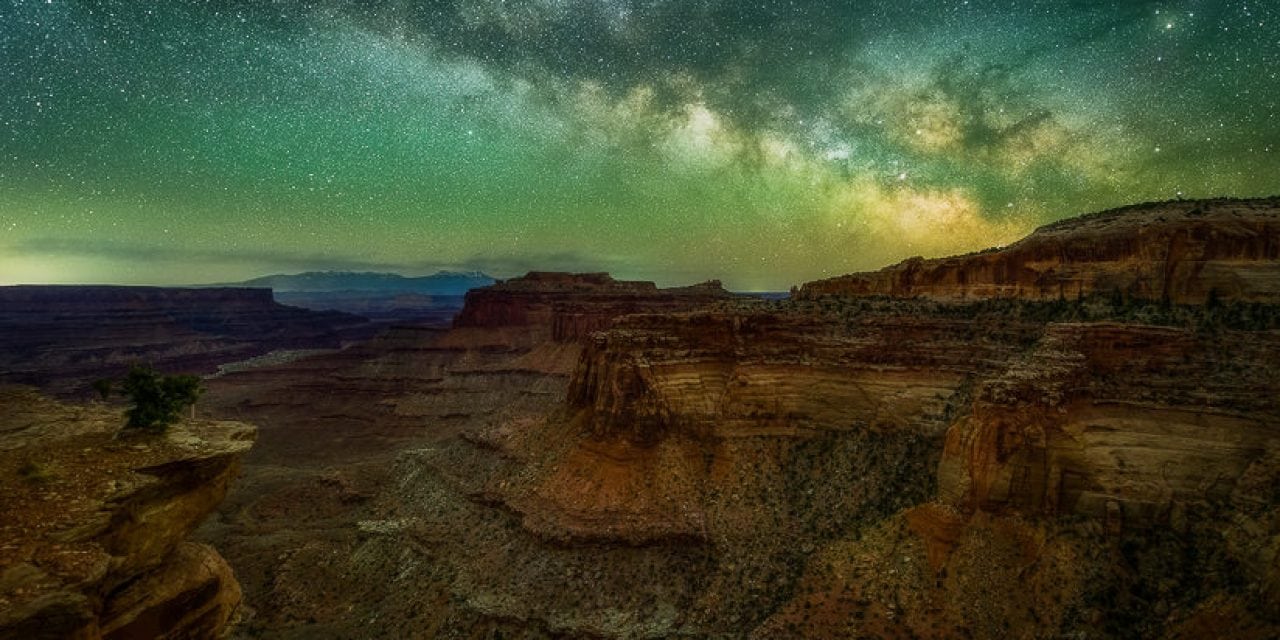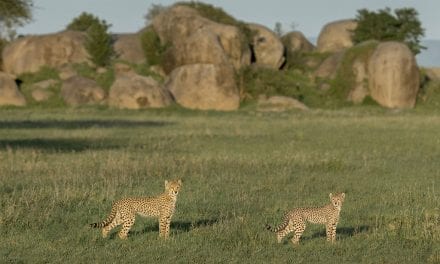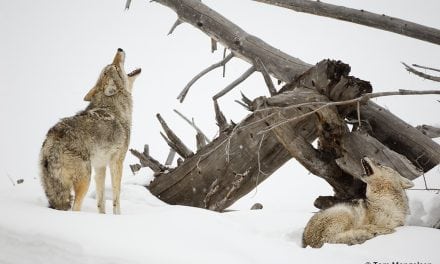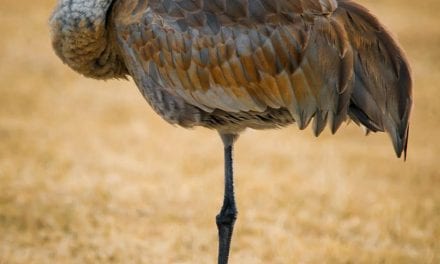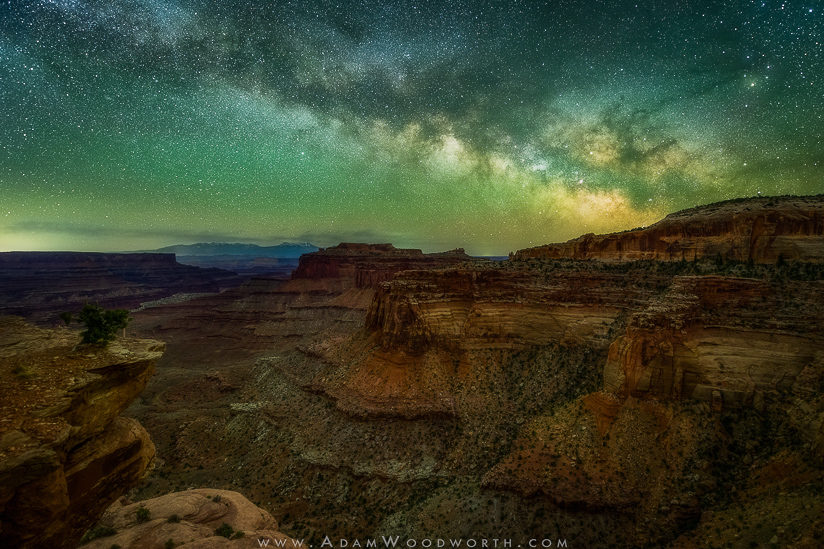
Introduction
If you’ve done any night photography, then you’re likely very familiar with the noise of exposures in low light using a high ISO. But the noise isn’t all just from the high ISO. If you exposure for a longer period of time, you’ll capture more light, and have a higher signal to noise ratio, meaning less noise. A higher signal will result in less noise even with a high ISO (depending on your camera, modern sensors are much better). However, when shooting the Milky Way you’re usually going for short star trails, or completely pinpoint (trail-less) stars, which means you’re limited in how long you can expose before the stars appear to move too much in the frame. So you’re stuck using a shutter speed that isn’t long enough to capture enough light for a high signal, and having to use a high ISO as well to boost the signal to a usable level, which can add additional noise to the image (although how much depends on your camera).
The result is that you’re usually shooting with a shutter speed that captures enough light for tolerable noise, but it’s also probably long enough that the stars trail in the frame. If you try shooting with a short enough shutter speed to capture completely motionless stars, the noise level can be so high (depending on your camera and lens f-stop) that the exposure is either unusable or needs a ridiculous amount of noise reduction, resulting in large size prints that can look very grainy or blocky due noise or noise reduction. Noise reduction tools these days are great, but they can’t fix everything all the time.
Fortunately there are ways to capture both pinpoint stars and achieve low noise. You can either use a star tracker with very long shutter speeds to capture a lot of light and thus a high signal to noise ratio, or you can use star stacking, a method of capturing multiple photos with shorter shutter speeds that are then aligned and averaged in software to reduce noise. Or you can combine a star tracker with star stacking for incredibly low noise.
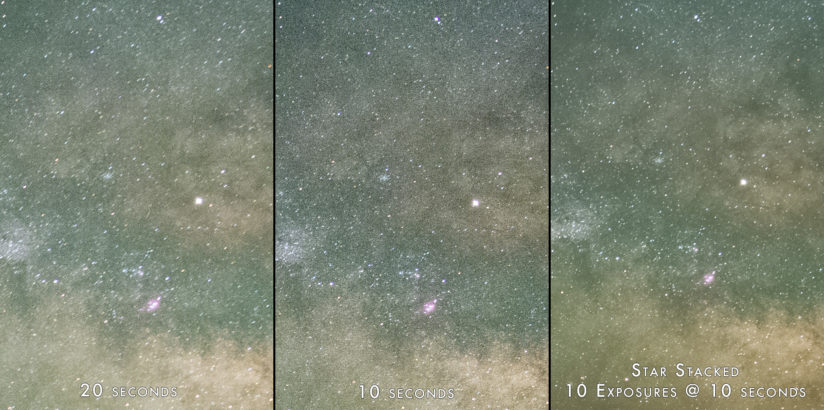
Center: 10 seconds @ ISO 12,800 – Pinpoint stars but more noise (brightened to show detail)
Right: Star stacked result of 10 exposures at 10 seconds each – Pinpoint stars and low noise
All shots with the Nikon D810A and Nikon 14-24mm f/2.8 lens @ 14mm and f/2.8
The image above contains three 100% crops from the same night, all shot with the Nikon D810A and the Nikon 14-24mm f/2.8 lens @ 14mm, f/2.8, and ISO 12,800. On the left is a shot taken with a shutter speed of 20 seconds, the center is 10 seconds, and the right is the star stacked result of 10 exposures at 10 seconds each. Notice how the image on the left has lower noise than the 10 second shot in the middle, but the image on the left also has longer star trails. By star stacking, we get the result on the right, pinpoint stars and low noise. It’s hard to tell on these small images on the web, but the noise in the star stacked result is much less than the noise in the 20 second exposure.
What About a Star Tracker?
Before we get into star stacking, you might be wondering if you could just us a star tracker, a device that sits on top of your tripod and turns with the rotation of the earth so that your camera can follow the stars, capturing long exposures with no star movement. You can certainly do this, but that requires lugging around the star tracker, and polar aligning the tracker every time you move your tripod. This is fine if you’re just doing shots of the sky without a foreground, but if you’re capturing the foreground then it will blur in the star tracked exposures, so if you want a sharp foreground you’ll need a separate exposure (or more than one) of the foreground with the tracker turned off. I do this anyways even without a tracker so that I can get detail and low noise in my foreground. Blending the static foreground shot with the star tracker shot would require dealing with blending the blurred foreground of the star tracker shot with the sharp foreground of the static shot. So, the blending gets more complex. However, you will definitely get more detail in the sky with a star tracker, since you’re able to capture much more light in a single exposure.
That said, if you don’t have a tracker or don’t want to deal with the complexity, then you might want to try star stacking.
What is Star Stacking?
Star stacking is a method of overlaying multiple night sky exposures of the same composition, aligning the images so the stars all line up between each exposure, then averaging the brightness & color values of those exposures, producing a result with far less noise than a single exposure. The noise differs between each exposure, and even from pixel to pixel in the same exposure the noise differences can be high, so the averaging process greatly reduces that variation, resulting in a much smoother sky.
You can extend this to get pinpoint stars by using a short enough shutter speed for your given focal length so that the stars do not appear to move in the frame. So you get the best of both worlds, pinpoint stars and low noise.
Low Noise Foreground
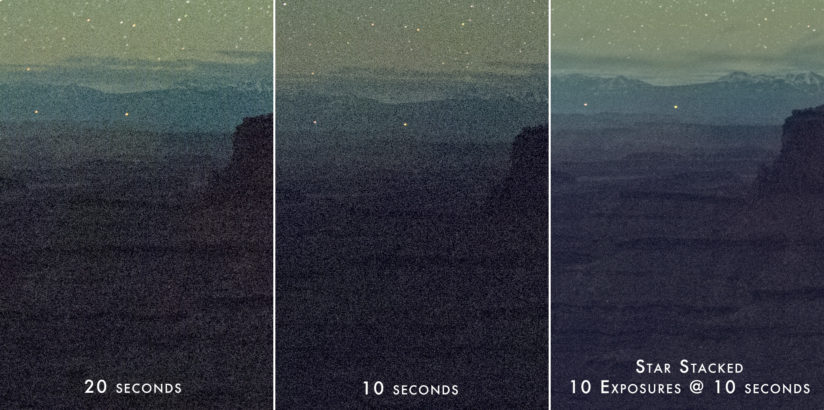
The star stacking method reduces noise in the entire image, not just the sky. Even though the sky is aligned separately from the foreground in the stacking process, the foreground area can still be stacked and averaged to reduce noise. Depending on the ambient light of the scene, this might mean that you don’t need to do any separate foreground exposures to get a foreground that has detail and is in focus with low noise. But, where I’m often shooting, this isn’t normally the case. I still will take separate foreground exposures at a lower ISO (normally ISO 1600), for longer shutter speeds (usually multiple minutes per exposure), and when needed I will change focus and take multiple foreground shots to get everything in focus.
In the image above you can see how stacking greatly reduces the noise in the foreground part of the image. The star stacked result is significantly cleaner and has more detail. However, the foreground is still too dark and too noisy because there simply just isn’t enough light collected from the foreground in 10 seconds, and while stacking cleans it up, it can’t bring out more detail that wasn’t captured in the first place. So I would take another exposure at ISO 1600 for several minutes, and blend that cleaner, brighter result with the star stacked result of the sky.
Exposure Settings for Star Stacking
Shutter Speed
Pick a shutter speed that will capture pinpoint stars with the focal length of the lens you are using. There is a complex formula that can be used to calculate this with respect to your location on earth, the direction your camera is pointing, your focal length, and the size of the photosites on your camera’s sensor, but an easier way is to use the “150 rule” (something I sort of made up, see below), or just start with half of the shutter speed you normally use that is generating noticeable star trails. Take a test shot and then zoom in on the LCD preview and see how the stars look. If they appear to be pinpoints, then try a longer exposure until they start to trail and go back from that, the goal is to find the longest possible exposure before the stars trail.
You may have heard of the “500 rule”, which is a simple way of determining your shutter speed for the stars so they don’t trail too much. You take your focal length (or the 35mm equivalent if you’re shooting on a crop sensor) and divide that into 500 to get the shutter speed. However, I find this rule to be far too sloppy, usually resulting in distractingly long star trails. If you’re looking for reasonable star trails and aren’t star stacking, try dividing into 400 or 300 instead.
For pinpoint stars, try dividing into 150 and then adjust from there to find the best shutter speed. For example, if you’re using a full frame camera with a 14mm lens, then 150 / 14 = 10.7 seconds, so I round down to 10 seconds. For 50mm, that would be 150 / 50 = 3 seconds, which may sound extremely short, but isn’t so bad if you have an f/1.4 lens. At f/1.4, you’re 1 stop away from f/2, and 2 stops away from f/2.8. Using the same shutter speed, going up an f-stop cuts the light in half, and going down an f-stop doubles the amount of light. So to capture the same amount of light when you increase your f-stop, you have to double your shutter speed. So, a 3 second shot at f/1.4 captures the same amount of light as a 6 second shot at f/2, or a 12 second shot at f/2.8.
Ultimately, just find the right shutter speed for your setup. Start with a shutter speed from one of the above methods and keep adjusting and testing from that point.
ISO
Generally speaking, you’ll need an ISO of 3200 or greater for star shots. The actual ISO you can use will depend on the amount of ambient light, your shutter speed, and your camera’s high ISO performance. Using a Nikon D5 or D850, I generally have no issue shooting as high as ISO 10,000 or 12,800 for night sky shots, but you also need to make sure you keep it low enough to avoid blowing out the stars.
In some cameras, if you’re star stacking with shutter speeds of around 10 seconds or less and your lens has strong vignetting at the aperture you’re using, you could end up with very strong magenta color noise issues along the edges of the frame when you apply vignette correction in your raw editor, which brightens the dark edges, revealing the color noise. This happens because the amount of light hitting the edges, in particular the corners, of the frame is much less than the amount of light hitting the center of the frame due to the vignetting of the lens, and if the light level is dark enough then you’re not overcoming the amplification/circuitry noise of the sensor and camera, so boosting the dark areas shows that noise. The solution here is to use a low enough ISO to prevent or at least minimize the amplification noise. Try ISO 3200 or less if you are experiencing this. If you can’t get rid of it, you can leave in the vignetting, or you can color correct the magenta fringing. An example of this issue and the solution is shown in my complete Milky Way photography editing workflow video tutorial.
F-Stop
You want to use the brightest (lowest f-stop number) aperture possible on your lens while still getting sharp stars. If you see coma distortion of your stars or general star flare, try stopping down a little bit at a time until it goes away or is minimized. You may have to live with some amount (or a lot) of coma distortion depending on your lens.
Number of Exposures & Intervalometer
Star stacking requires capturing multiple shots at the same shutter speed so that they can be aligned and averaged later. The more shots you have, the less noisy the star stacked result will be, but only up to a point before sensor pattern noise starts being visible, or you completely exhaust the signal to noise ratio.
In general, I’ve found 10 exposures to be plenty to give a result with very low noise. I’ve done as much as 20, but sensor pattern noise starts to become an issue around there. But even 5 stacked exposures will make a big difference in noise. Experiment and see what works for you.
You can take the shots manually by just hitting the shutter button multiple times, but a much easier way is to use an intervalometer that can be programmed to shoot X amount of shots at Y seconds each. Some cameras, like many of the full frame Nikons, have a built in intervalometer that can be used, or you can get an external remote/intervalometer. I love the Promote, but the Vello Shutterboss or Neewer intervalometers work well, but note that almost any intervalometer seems to have an issue with cable reliability. I used to use the Shutterboss as my primary remote, but I went through 3 of them in a year because the cables kept breaking. The Promote has replaceable cables, and I’ve gone through a few of them, but in the long run the Promote is cheaper than continuing to buy less expensive remotes. Just make sure you get the correct remote (or cable) for you camera. Use the Nikon 10-pin connection for pro full frame Nikons that support the 10-pin connection, other Nikons (including some full frames) need the USB cable. There are separate cables for Sony, Canon, etc.
Example Settings for Star Stacking
Here are some example exposure settings for star stacking at various focal lengths. ISO 3200 or higher would normally be used for all of these. On my Nikon D850, I’m often using ISO 6400 or higher. Remember that you need to take several exposures for star stacking, at least 5, but I normally take 10.
Focal length: 14mm
Shutter speed: 10 seconds
Focal length: 24mm
Shutter speed: 6 seconds
Focal length: 50mm
Shutter speed: 3 seconds
Star Stacking Software
Star stacking isn’t anything new, pure astrophotographers (space images without a landscape) have been doing this for a long time, and use programs such as Deep Sky Stacker, among many others, to do the stacking. But landscape astrophotography requires the alignment of the stars in the exposures to happen without the static foreground objects messing up the alignment. This can be done manually in Photoshop, but there are a couple of software programs that are designed for star stacking with landscape astrophotographs, and they make the process much, much easier.
Mac: Starry Landscape Stacker
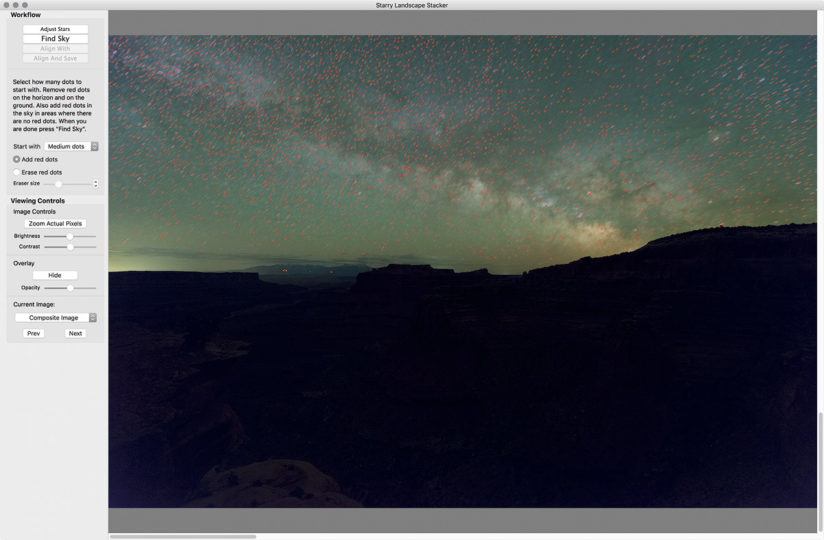
Starry Landscape Stacker is the program I use, it is incredibly good at automatically finding the stars to make a mask for the sky, so that the foreground is not included in the alignment process. You can help the program find the sky by adding red dots that indicate where the sky boundary is located, and you can fine tune the auto generated mask with a paintbrush. Starry Landscape Stacker has some other great features, like letting you pick which frame to align with, this is great for when you want to align the stars to a particular frame where the stars are situated nicely against the foreground. Believe it or not, the stars will move enough in the 100 seconds (10 seconds x 10 exposures, or however long your stacking is) such that this is a very handy feature.
Starry Landscape Stacker is available in the Mac App Store, and a free trial is available that has all the features but outputs images with a watermark.
You can read more about it here, and Ralph Hill, the author of Starry Landscape Stacker, has a great collection of video tutorials on how to use the program here.
Windows: Sequator
I do not have any experience with Sequator, but it is the star stacking program available for Windows that can deal with landscape foreground masking, like Starry Landscape Stacker above.
Sequator is free and available here, and this is a good video walk-though of Sequator.
Photoshop
Star stacking with landscape foregrounds can be done in Photoshop, but it is a tedious pain, and in my past experience Photoshop sometimes fails to align all the stars, particularly towards the edges of the frames. You can learn how to do it via example in my Milky Way photography editing workflow video, or with Lonely Speck’s video, but I strongly suggest using one of the programs above instead.
Blending Sky and Foreground
After you complete the star stacking steps, you can take the resulting noise-reduced sky image and blend it in Photoshop with foreground exposures from the same scene to produce your final image that will have the entire scene well exposed, sharp, and with low noise from the foreground to the stars. I cover the basics of this in my Milky Way photography editing workflow video tutorial.
Practice!
Now that you know what star stacking is all about and how to do it, head out on the next clear moonless night and give it a try! Figure out the best shutter speeds for your favorite focal lengths, and practice with one of the software tools mentioned above.
Happy Shooting!
Learn more about Milky Way shooting & editing techniques through tutorials available at Adam’s website, adamwoodworth.com.
The post Star Stacking For Pinpoint Stars And Low Noise appeared first on Outdoor Photographer.

